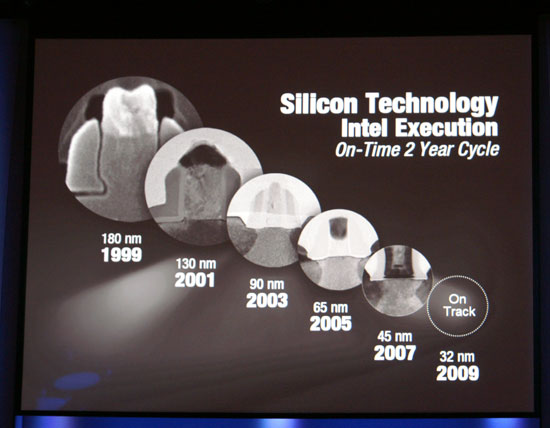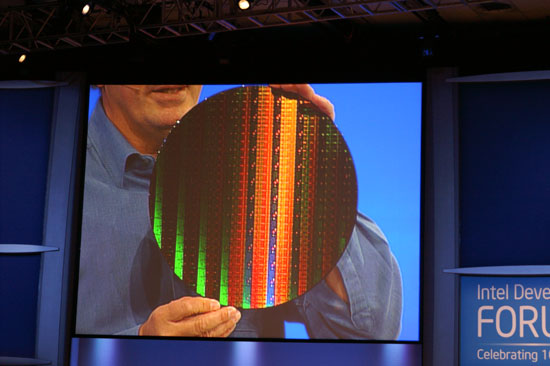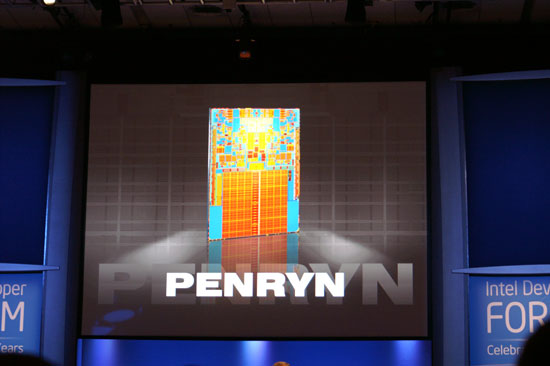Intel Developer Forum 2007 - Day 1: Nehalem, Intel's GPUs, 32nm and More
by Anand Lal Shimpi on September 18, 2007 1:17 PM EST- Posted in
- Trade Shows
We're privy to a special IDF this year, it's the 10 year anniversary of the conference and Intel is understandably excited. The show started off with Intel's President and CEO, Paul Otellini giving us a broad update on the company and its roadmap.
45nm: The Enabler
Otellini confirmed what we already know, that Intel's 45nm process will be the enabler to bring us technologies such as integrated graphics on CPUs (similar to AMD's Fusion strategy), octo-core CPUs, system on a chip designs and a highly parallel x86 design that we've come to know as Larrabee.

Intel's integrated graphics on 45nm announcement isn't anything new, Intel originally told us that certain versions of Nehalem would be available with integrated graphics and we expect to see that
Silverthorne is Intel's very simple x86 system-on-a-chip design, which will hopefully make its way into everything from smart phones to digital TVs. UMPCs may also use Silverthorne for particularly mobile form factors, hopefully fixing many of the problems with today's UMPCs.
32nm on track for 2009
Intel confirmed that its manufacturing expertise is still strong and that it fully expects to introduce the first 32nm products in 2009, just two years from now.

As always, when you're bringing up a new process you want to try manufacturing simpler devices first and thus Intel showed off a SRAM wafer built on its 32nm process. Each die on the wafer had a 291Mbit SRAM composed of an incredible 1.9 billion transistors.

The Penryn Update
Penryn is coming, we've previewed it already and we should get more performance data at the show. The official launch date is November 12th, and Penryn is the first of 20 microprocessors being developed on 45nm. The introduction in November will be for servers and high end desktops, followed by a mainstream release in Q1 2008.

Intel also confirmed that its 45nm processors and the 65nm chipsets that support them will be Halogen free as well as Lead free.










23 Comments
View All Comments
coldpower27 - Wednesday, September 19, 2007 - link
It looks like Nehalem is coming in in both Native Quad Core and Native Octo Core configuration, no intermediate MCM Octo Core this time around.JackPack - Tuesday, September 18, 2007 - link
Not incorrect.Nehalem is a modular design. There is a monolithic 8 core version of Nehalem for MP systems.
AmberClad - Tuesday, September 18, 2007 - link
According to http://techreport.com/discussions.x/13232">TechReport: 'In its "largest configuration," Nehalem will pack eight CPU cores onto a single die'.Martimus - Tuesday, September 18, 2007 - link
You showed some interesting stuff, and I read through the article with interest. What really threw me was your symantics. You sounded more like an Intel salesman than a reviewer. things like like it matters if Intels solution makes it's way there versus someone elses solution. Or when you say which is just a pure guess at this point. If you say "may" instead of "fully expected to", it wouldn't sound like a used car salesman trying to covince me that this is already a done deal. I already get that enough from my contractors trying to convince me that their product has some magical properties that make it head and shoulders above the competition.fitten - Tuesday, September 18, 2007 - link
I don't read it like that at all...For example:
[quote]
Silverthorne is Intel's very simple x86 system-on-a-chip design, which Intel hopes will hopefully make its way into everything from smart phones to digital TVs[/quote]
[/quote]
Nehalem is fully expected by Intel to close the gap between AMD and Intel when it comes to memory performance and multi-processor scalability.[/quote]
Would you argue either of those are false?
Martimus - Tuesday, September 18, 2007 - link
That would be the best way of putting it I think. Those two adjustments you made make it sound much better. The current writing implies a bias of the writer, but yours implies a bias from the company, which is to be expected. I'm not sure why it upset me to see my favorite site writing an article that seemed to show a favoritism toward a particular company, but I think it had more to do with the fact that I don't want to have to worry about the site that I use to make purchasing decisions having a bias. I want to be able to trust this site, because it is stressful when you lose confidence in the people you look to for help.JarredWalton - Tuesday, September 18, 2007 - link
Just remember: this is the *Intel* Developer Forum, so any reporting is basically an overview of what Intel is saying and planning. Tradeshow articles don't tend to be quite as in-depth as actual reviews, and while we don't always explicitly state it or make it clear, meetings with any manufacturers are always them telling us what they hope/plan/want/etc.Nfarce - Tuesday, September 18, 2007 - link
Huh. That is exactly the way I read it. Methinks a fanboi got just a tad overzealous in the bias accusation department and read more into it than was meant to portray. Geez.Roy2001 - Tuesday, September 18, 2007 - link
Intel roadmap is impressive and they excuted well recently.code65536 - Tuesday, September 18, 2007 - link
Penyrn hasn't even been launched yet, and Intel is already demonstrating Penryn's successor? Well, they're certainly on top of things...